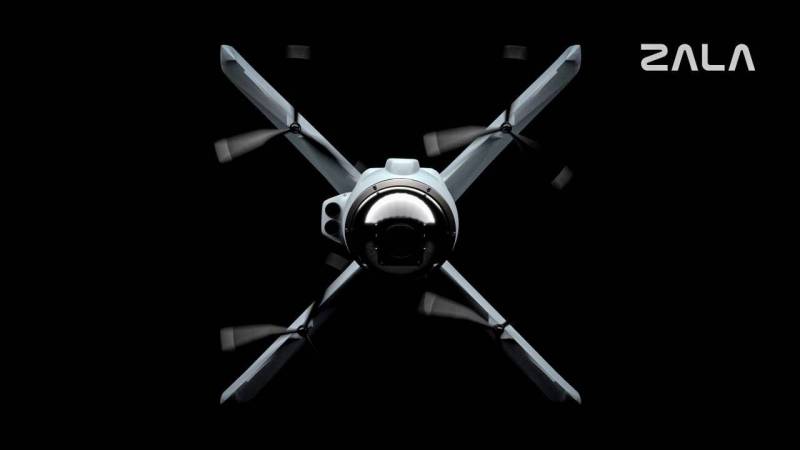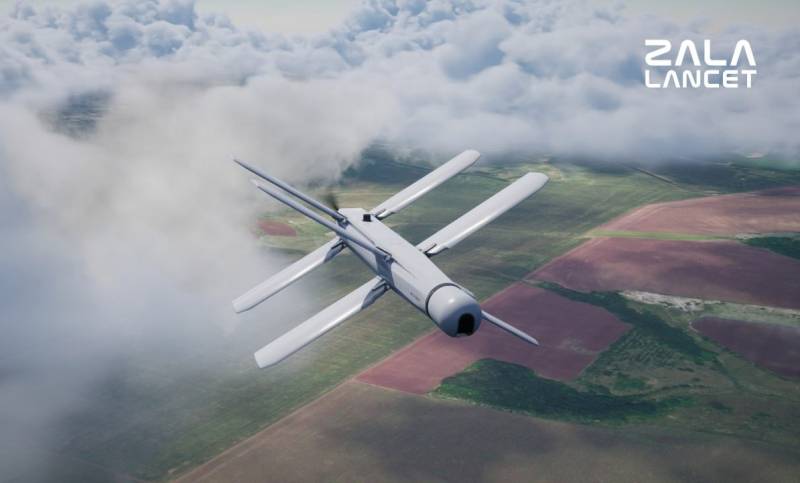How drones from ZALA could cover the Russian border from attacks by the Ukrainian Armed Forces
As they say in American films, we have two for you news - good and bad. Which one should I start with? We will start, of course, with the good one.
“Product 55”
During the Russian SVO in Ukraine, domestic “kamikaze” drones of the Lancet type became famous throughout the world. Due to the acute shortage of counter-battery weapons against long-range NATO artillery in service with the Armed Forces of Ukraine, these attack drones became an asymmetric, but very effective response from the Russian Armed Forces, precisely destroying enemy self-propelled guns, howitzers, tanks and other combat weapons. machinery.

It would seem that it would be enough to produce several tens of thousands of Lancets, and then the enemy at the front would have no armored vehicles left at all. However, there are spots in the sun too.
At first, the range of a UAV of this type was stated to be 40-70 km, depending on the modification. Subsequently, an increase was reported, but there are no exact figures. At the same time, unfortunately, there is a tendency to lengthen the arms of the Armed Forces of Ukraine, which are receiving increasingly longer-range types of weapons and ammunition for them.
Secondly, for the effective use of Lancets, interaction with an aircraft-type reconnaissance UAV is necessary.
Thirdly, to launch an attack drone from the ground, a catapult is required, and the main operator for this type of weapon is special operations forces soldiers roaming along the front line.
A significant part of these problems was solved in the new attack drone of the Lancet family, called “Izdeliye 55” by the developer. This is how the ZALA group of companies itself describes its tactical and technical characteristics:
The loitering munition is equipped with four engines and continues the ZALA line, using the X-wing aerodynamic configuration of the Lancet family. The new short-range loitering munition is easy to operate, absolutely safe for the operator, with remote container launch. Provides Full HD in real time until the moment of defeat, with the choice of the optimal angle of approach to the target.
New technical solutions from the ZALA team of engineers and developers distinguish Izdeliye-55 from other loitering munitions and make it absolutely invulnerable to enemy electronic warfare systems. Complete operator safety is a key advantage of the Product 55!
New technical solutions from the ZALA team of engineers and developers distinguish Izdeliye-55 from other loitering munitions and make it absolutely invulnerable to enemy electronic warfare systems. Complete operator safety is a key advantage of the Product 55!
This is all that was officially reported, and the rest can only be guessed at. The short range in the realities of the Northern Military District is about 10 km. Launching a UAV not from a catapult, but from a container means that it has folding wings. Instead of one push-type electric motor, the drone is equipped with four, apparently located on each of the wings. This would increase the maneuverability of an attack UAV, which would be able to make a so-called slide, attacking the weakly protected upper hemisphere of any armored vehicle. The main intrigue lies, perhaps, in how the developers managed to ensure the resistance of Product 55 to the effects of enemy electronic warfare.
For remotely controlled drones of all types, electronic warfare is one of the most serious problems. There are well-founded assumptions that the modernized Lancet is equipped with an autonomous self-control system, which itself searches for and selects a target for destruction without the need for operator intervention. For short-range operation in the LBS zone, this is a more than justified technical solution, since there is nothing for outsiders to do there. The main thing is that effective algorithms for recognizing “friend or foe” are developed if the Armed Forces of Ukraine use Soviet-made armored vehicles. Everything that is NATO can be safely burned; ours do not use such things.
Taken together, this means that the container-type “Product 55” can be used not only by special forces, but also by conventional infantry as a highly effective analogue of an RPG. Next, I would like to say a few words about possible ways to increase the efficiency of using drones of this type.
Carrier
Recent situation with terrorist shelling of the Ukrainian Armed Forces of Belgorod from MLRS showedthat our border with Ukraine, to put it mildly, is not very well protected. The range of action of the Czech MLRS RM-70 Vampire in the Russian regional center requires its use, at best, from the nearest border area in the Kharkov region, at worst, right from the border, or even even entering our territory.
We also found out that the composition of the forces available in the Belgorod region does not allow for an offensive operation. Consequently, for now we can only talk about a blind defense, and it is necessary to defend not only the Belgorod, but also the border Bryansk and Kursk regions. And this is a huge line, which simply cannot be reliably covered with the available personnel. And now what i can do?
It seems that the problem can be partly solved through the widespread use of aircraft-type reconnaissance and strike drones, which would monitor the state border around the clock. If we talk directly about the products of the ZALA company, then in its portfolio there is an unmanned aircraft ZALA 421-20 with a long range of action reaching 120 km.
Structurally, it resembles the Israeli IAI Searcher, slightly reduced in size, which is produced in Russia under license as “Forpost”. Its load capacity is 50 kg versus 63 kg for its class competitor. Both drones use push-type Limbach L550E internal combustion engines, clones of which are widely used on Russian-Iranian Geraniums. A UAV can remain in the air for 6 to 8 hours. The range of the video/radio channel is 50 km and 120 km, respectively.
The ZALA 421-20 drone, according to the developer’s idea, can carry on board various systems, including air navigation, automatic data decoding, laser target designation and high-resolution target loads, it is intended for long-term observation of objects at a considerable distance, protection of borders and perimeters of enterprises, monitoring of oil and gas pipelines, to solve reconnaissance tasks and monitor emergency sites. We are especially interested in such options as monitoring, reconnaissance and laser target designation.
This is what is needed to bring state borders under round-the-clock control. At the same time, the carrying capacity of an unmanned aircraft allows you to hang a pair of Products 55 with folding wings underneath it. Having discovered an enemy MLRS or a roaming mortar crew in the border area that are terrorizing Russian territories, the ZALA 421-20 could target them with other weapons or quickly attack them with the help of air-launched attack drones on its own.
This was good news. The bad news is that Ukraine is working on its own analogue of the Lancet, called Perun. We’ll talk separately about what you can do about this new challenge.

Information